
ipsi501/iStock/Getty Images
Holidays can be a trying time, and when you're preparing a special holiday ham, you might be tempted to skip thawing and stick it right in the oven. Though it seems this would give you more time to focus on side dishes or other holiday tasks, it isn't a good idea. Results can include at best a ruined a dinner and at worst, a trip to the emergency room.
Cooking Considerations
One reason it isn't a great idea to cook a frozen ham without thawing is that the cooking process may not work properly. Ovens heat food from the outside in. According to food network star Alton Brown, ovens work primarily through gradient heat bouncing off the walls and striking the food. Frozen ham is more resistant to heat, so the outside of your ham may burn before the inside is cooked through.
Safety Considerations
Another problem with cooking frozen hams is potential illness. The U.S. Department of Agriculture recommends cooking "precooked" hams to 140 degrees F and raw hams to at least 160 degrees. Dangerous bacteria multiply quickly at temperatures between 40 degrees and 140 degrees. Since the center of a frozen ham cooks far more slowly than the center of a thawed ham, it may sit in this danger zone long enough for dangerous microbes to grow and cause food poisoning.
Miscellaneous Problems
If improper cooking and potential food-borne illness aren't enough to convince you to thaw your ham before roasting, the annoyances of working with frozen ham might. If you want to execute the traditional diamond pattern, you're going to have a hard time carving it into a rock-hard, icy ham. Glazes and crusts are no easier. As the ham thaws, it will release moisture, causing whatever you put on the ham to fall off and pool in your roasting pan.
Alternatives
Depending on your specific concerns, you have alternatives to cooking frozen ham that don't have the same potential problems. If convenience is the issue, use cold water thawing, which requires little monitoring. To do this, fill a food-safe bucket with cold water, set it in your kitchen sink, add a wrapped ham, and set your faucet to trickle small amount of water into the bucket. Or, you can by a refrigerated ham, which requires no thawing before cooking.
Related Articles
Can You Freeze a Spiral Ham?
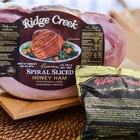
Cooking Instructions for a Ridge Creek ...

How to Defrost a Bone-In Ham
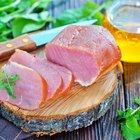
How to Reheat a Ham
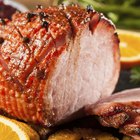
How to Cook Ham in a Roaster
What Is the Safe Cooking Temperature ...

How to Store Uncooked Smoked Ham
Cooking Directions for Bone-in Smoked ...

How Do I Roast a Picnic Ham?

Quick Method for Thawing Frozen Bread ...

Can You Cook Frozen Dinners in Glass?

How Long Can Frozen Food Sit Out Before ...

Shank Ham Cooking Directions

How to Fully Cook a Hickory Smoked Ham
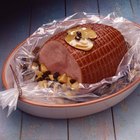
How to Cook a Daisy Ham

How to Heat Pre-Cooked Hams
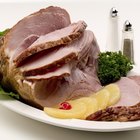
How to Cook a Ham in a Crock-Pot vs. ...
Can I Freeze Split Pea Soup With Ham ...
Can You Cook Frozen Chicken?
How Long to Thaw a Frozen Turkey
References
- "I'm Just Here for the Food"; Alton Brown; 2002
Writer Bio
Melanie Greenwood has been a freelance writer since 2010. Her work has appeared in "The Denver Post" as well as various online publications. She resides in northern Colorado and she works helping to care for elderly and at-risk individuals. Greenwood holds a Bachelor of Arts in pastoral leadership from Bethany University in California.
Photo Credits
ipsi501/iStock/Getty Images